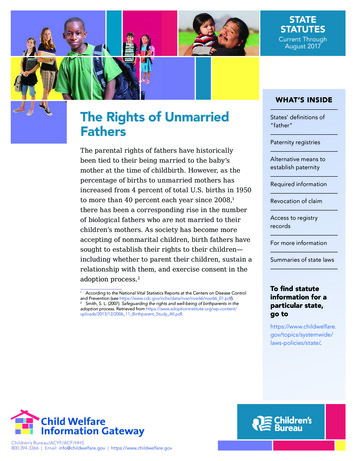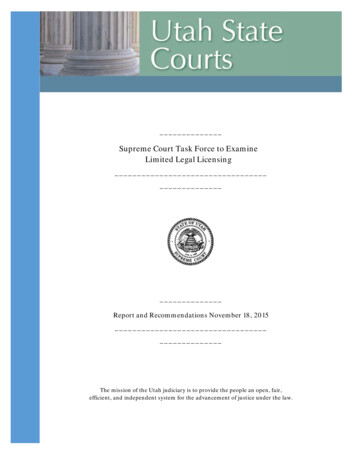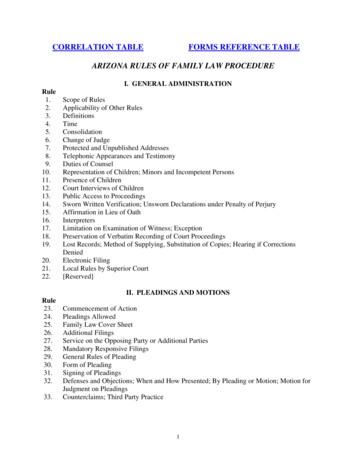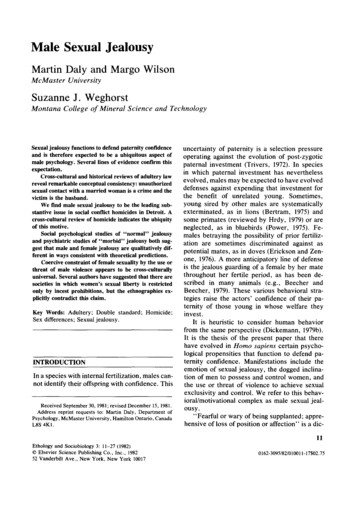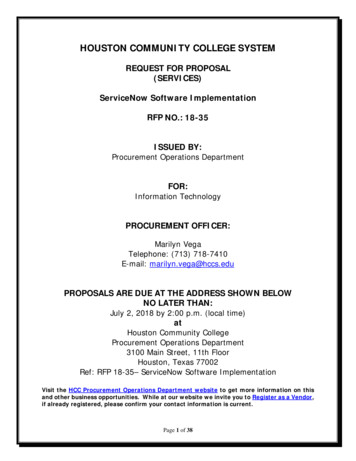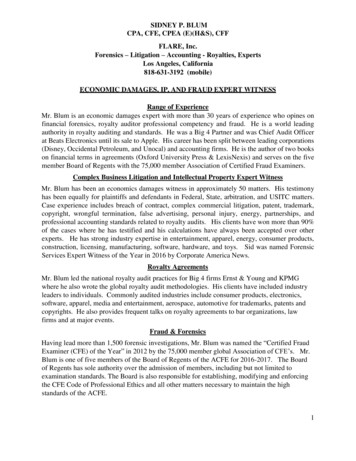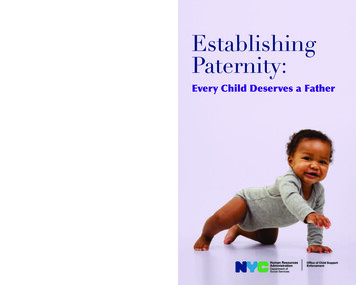
Transcription
EstablishingPaternity:Every Child Deserves a FatherBill de BlasioSteven BanksW549ERev. 11/14 Copyright 2014, The City of New York. Human Resources Administration/ Department ofSocial Services. For permission to reproduce all or part of this material contact the New YorkCity Human Resources AdministrationOffice of Child SupportEnforcement
ESTABLISHINGPATERNITYEstablishing paternity refers to the legalidentification of the father of a child born tounmarried parents. If you are an unmarried parent,or parent-to-be, please read the followinginformation on paternity.Some Facts to ConsiderAccording to the U.S. Department of Health andHuman Services, having the presence of twoinvolved parents contributes directly to betterschool performance, reduced drug abuse, lesscrime and delinquency, fewer emotional andother behavior problems, less risk of abuse andneglect, and lower risk of teen suicide.Establishing paternity when your baby is borndoes not guarantee a lifelong relationshipbetween father and child, but it is a good start.For More Information Contact:Who Should Establish Paternity 1Unmarried biological parentsParents who get married after the child isbornTeen parents (they do not need their ownparents’ consent)Parents who are immigrants, includingthose who are not citizens and those whoare undocumented, even if either or bothdo not have valid social security numbers.They will not be asked about their immigration status and any information obtained to establish paternity and/or childsupport will not be shared with the U.S.Citizenship and Immigration Services The Birth Registrar in the hospital orbirthing facility where your child was born HRA Office of Child Support EnforcementOutreach Services Unit: 929-221-5008 NYC Department of Health and MentalHygiene: 212-788-4500 HRA Website:nyc.gov/hra/ocse10
Canceling an Acknowledgmentof Paternity If either parent wants to cancel the AOPafter it has been filed with DOHMH, a courthearing is required.Either parent may file a petition to vacatethe AOP with the court.If a parent was 18 years or older whensigning the AOP, he/she must file by theearlier of 60 days after signing the AOP, or 60 days after having to answer any courtpetition about the child.Benefits of Establishing PaternityIf a parent was younger than 18 years whensigning the AOP, he/she must file by theearlier ofFor the Mother Shared parental responsibilities More financial security for the family 60 days after reaching age 18, or 60 days after having to answer any courtpetition about the child if the parent wasadvised of the right to cancel the AOP ata proceeding related to the child.After these time limits, the parent filing thepetition must show proof of fraud, duress, ormaterial mistake of fact. 9The Support Magistrate will decide if theAcknowledgment of Paternity should becanceled, based on the facts presented atthe hearing and the best interests of thechild. It is possible that someone who is notthe biological father may continue to belegally obligated to pay child support.That’s why you should be sure of the father’sidentity before establishing paternity.For the Father Legal establishment of parental rightsand responsibilities Name appears on the child’s birthcertificate Right to seek court-ordered visitationand/or custody Right to be consulted in adoption or otherlegal proceedings concerning the childFor the Child Legal record of the identity of the father Father’s name on the birth certificate Information about family medical history Financial support from both parents Entitlement to medical insurance, socialsecurity and veterans benefits, andmilitary allowances from the father Rights of inheritance if the father dies2
How Paternity Is EstablishedThere are two ways to establish paternity.Paternity can be established through a voluntaryprocess, by signing an Acknowledgment ofPaternity (AOP), or through a judicial processwhich means going to court.Voluntary Establishment of PaternityDocuments You Will NeedFor a NewbornAt the hospital or birthing center where yourbaby is born, you will be asked questions aboutyour marital status to determine whether youmay establish paternity by filling out theAcknowledgment of Paternity. You will need tobring your current marriage certificate or divorcedecree, if you have one. In addition, be preparedto show photo identification, since your signatureon the AOP must be witnessed.If both parents agree, they can sign an Acknowledgment of Paternity (AOP) as soon as the baby isborn. AOP forms are available in the medical officeor clinic where you get your prenatal care and inthe hospital or birthing center where your baby isborn. The mother and father do not have to signthe form at the same time or in the same location.3When paternity is established, DOHMH sends theinformation to the New York State Putative FatherRegistry (PFR) (“putative“ means “alleged“ or“presumed“) The PFR is a list of fathers who haveestablished paternity in New York State. Theinformation is used in issues of inheritance andadoption and any other legal issues that requirenotifying a child’s father.8
Paternity and the Departmentof Health and Mental HygieneWhen paternity is established, the AOP or Order ofFiliation (court order that establishes paternity) issent to the NYC Department of Health and MentalHygiene (DOHMH) for registration. They, in turn,provide parents with certified copies of theirchild’s birth certificate and AOP. If paternity isestablished after the birth certificate has beenregistered, the birth certificate will be amended toinclude the father’s name.After the Baby Leaves the HospitalPaternity can be established any time after thebaby leaves the hospital. This is true until thechild turns 21 years old. You may use the AOP formthat you were given in the hospital where yourbaby was born. You can also get one from the NYCDepartment of Health and Mental Hygiene(DOHMH) or the NYC Human ResourcesAdministration (HRA) Office of Child SupportEnforcement. They are also available online at:childsupport.ny.gov/dcse/aop forms.html.The completed, signed, and witnessed AOP mustbe sent or brought in person to the:New York City Department of Health and Mental HygieneOffice of Vital Records/Corrections Unit – Room 144125 Worth Street, Box 4New York, NY 10013Do not return the completed form to the hospitalwhere the baby was born. They will not be able toprocess it once the original birth certificate has beenfiled with the Department of Health and Mental Hygiene.74
Do Not Sign the Acknowledgmentof Paternity Form If: The baby has not been born yetEither parent is not sure who the baby’s father isThe baby’s parents are married to each otherThe mother is legally married to someone who isnot the fatherQuestion of Who the Father IsPaternity Establishment in CourtPaternity can be established in family court if:5 An Acknowledgment of Paternity has not been signed. The mother is married to someone other than the baby’sbiological father. Even if she has not been in contact with herhusband and knows he is not the father, a court hearing isnecessary to exclude him and establish the biological father asthe legal father. The parents are in court for a child support hearing and paternityhas not been established.If either parent has any doubt about the identity of the father, do not sign the Acknowledgment of Paternity. You may request low-costDNA testing, which is available to married andunmarried parents. Ask the birth registrar in thehospital or contact OCSE at 929-221-5008 for areferral to a New York State-certified laboratory.If the DNA test identifies the father, unmarriedparents still need to establish paternity by signingan AOP or by having a court hearing. AlthoughDNA testing can determine the identity of the biological father, it does not establish legal paternity.6
Do Not Sign the Acknowledgmentof Paternity Form If: The baby has not been born yetEither parent is not sure who the baby’s father isThe baby’s parents are married to each otherThe mother is legally married to someone who isnot the fatherQuestion of Who the Father IsPaternity Establishment in CourtPaternity can be established in family court if:5 An Acknowledgment of Paternity has not been signed. The mother is married to someone other than the baby’sbiological father. Even if she has not been in contact with herhusband and knows he is not the father, a court hearing isnecessary to exclude him and establish the biological father asthe legal father. The parents are in court for a child support hearing and paternityhas not been established.If either parent has any doubt about the identity of the father, do not sign the Acknowledgment of Paternity. You may request low-costDNA testing, which is available to married andunmarried parents. Ask the birth registrar in thehospital or contact OCSE at 929-221-5008 for areferral to a New York State-certified laboratory.If the DNA test identifies the father, unmarriedparents still need to establish paternity by signingan AOP or by having a court hearing. AlthoughDNA testing can determine the identity of the biological father, it does not establish legal paternity.6
Paternity and the Departmentof Health and Mental HygieneWhen paternity is established, the AOP or Order ofFiliation (court order that establishes paternity) issent to the NYC Department of Health and MentalHygiene (DOHMH) for registration. They, in turn,provide parents with certified copies of theirchild’s birth certificate and AOP. If paternity isestablished after the birth certificate has beenregistered, the birth certificate will be amended toinclude the father’s name.After the Baby Leaves the HospitalPaternity can be established any time after thebaby leaves the hospital. This is true until thechild turns 21 years old. You may use the AOP formthat you were given in the hospital where yourbaby was born. You can also get one from the NYCDepartment of Health and Mental Hygiene(DOHMH) or the NYC Human ResourcesAdministration (HRA) Office of Child SupportEnforcement. They are also available online at:childsupport.ny.gov/dcse/aop forms.html.The completed, signed, and witnessed AOP mustbe sent or brought in person to the:New York City Department of Health and Mental HygieneOffice of Vital Records/Corrections Unit – Room 144125 Worth Street, Box 4New York, NY 10013Do not return the completed form to the hospitalwhere the baby was born. They will not be able toprocess it once the original birth certificate has beenfiled with the Department of Health and Mental Hygiene.74
How Paternity Is EstablishedThere are two ways to establish paternity.Paternity can be established through a voluntaryprocess, by signing an Acknowledgment ofPaternity (AOP), or through a judicial processwhich means going to court.Voluntary Establishment of PaternityDocuments You Will NeedFor a NewbornAt the hospital or birthing center where yourbaby is born, you will be asked questions aboutyour marital status to determine whether youmay establish paternity by filling out theAcknowledgment of Paternity. You will need tobring your current marriage certificate or divorcedecree, if you have one. In addition, be preparedto show photo identification, since your signatureon the AOP must be witnessed.If both parents agree, they can sign an Acknowledgment of Paternity (AOP) as soon as the baby isborn. AOP forms are available in the medical officeor clinic where you get your prenatal care and inthe hospital or birthing center where your baby isborn. The mother and father do not have to signthe form at the same time or in the same location.3When paternity is established, DOHMH sends theinformation to the New York State Putative FatherRegistry (PFR) (“putative“ means “alleged“ or“presumed“) The PFR is a list of fathers who haveestablished paternity in New York State. Theinformation is used in issues of inheritance andadoption and any other legal issues that requirenotifying a child’s father.8
Canceling an Acknowledgmentof Paternity If either parent wants to cancel the AOPafter it has been filed with DOHMH, a courthearing is required.Either parent may file a petition to vacatethe AOP with the court.If a parent was 18 years or older whensigning the AOP, he/she must file by theearlier of 60 days after signing the AOP, or 60 days after having to answer any courtpetition about the child.Benefits of Establishing PaternityIf a parent was younger than 18 years whensigning the AOP, he/she must file by theearlier ofFor the Mother Shared parental responsibilities More financial security for the family 60 days after reaching age 18, or 60 days after having to answer any courtpetition about the child if the parent wasadvised of the right to cancel the AOP ata proceeding related to the child.After these time limits, the parent filing thepetition must show proof of fraud, duress, ormaterial mistake of fact. 9The Support Magistrate will decide if theAcknowledgment of Paternity should becanceled, based on the facts presented atthe hearing and the best interests of thechild. It is possible that someone who is notthe biological father may continue to belegally obligated to pay child support.That’s why you should be sure of the father’sidentity before establishing paternity.For the Father Legal establishment of parental rightsand responsibilities Name appears on the child’s birthcertificate Right to seek court-ordered visitationand/or custody Right to be consulted in adoption or otherlegal proceedings concerning the childFor the Child Legal record of the identity of the father Father’s name on the birth certificate Information about family medical history Financial support from both parents Entitlement to medical insurance, socialsecurity and veterans benefits, andmilitary allowances from the father Rights of inheritance if the father dies2
ESTABLISHINGPATERNITYEstablishing paternity refers to the legalidentification of the father of a child born tounmarried parents. If you are an unmarried parent,or parent-to-be, please read the followinginformation on paternity.Some Facts to ConsiderAccording to the U.S. Department of Health andHuman Services, having the presence of twoinvolved parents contributes directly to betterschool performance, reduced drug abuse, lesscrime and delinquency, fewer emotional andother behavior problems, less risk of abuse andneglect, and lower risk of teen suicide.Establishing paternity when your baby is borndoes not guarantee a lifelong relationshipbetween father and child, but it is a good start.For More Information Contact:Who Should Establish Paternity 1Unmarried biological parentsParents who get married after the child isbornTeen parents (they do not need their ownparents’ consent)Parents who are immigrants, includingthose who are not citizens and those whoare undocumented, even if either or bothdo not have valid social security numbers.They will not be asked about their immigration status and any information obtained to establish paternity and/or childsupport will not be shared with the U.S.Citizenship and Immigration Services The Birth Registrar in the hospital orbirthing facility where your child was born HRA Office of Child Support EnforcementOutreach Services Unit: 929-221-5008 NYC Department of Health and MentalHygiene: 212-788-4500 HRA Website:nyc.gov/hra/ocse10
EstablishingPaternity:Every Child Deserves a FatherBill de BlasioSteven BanksW549ERev. 11/14 Copyright 2014, The City of New York. Human Resources Administration/ Department ofSocial Services. For permission to reproduce all or part of this material contact the New YorkCity Human Resources AdministrationOffice of Child SupportEnforcement
The baby has not been born yet Either parent is not sure who the baby’s father is The baby’s parents are married to each other The mother is legally married to someone who is not the father Paternity Establishment in Court Paternity can be established in family court if: An Acknowle
